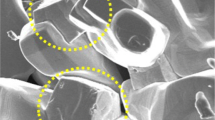Abstract
The reliability of fundamental studies of superconductivity depends on the quality of the materials under study. Optical zone melting yields high-quality single crystals without impurities, which can be difficult for other technologies. The paper describes the growth procedure for single crystals of several families of superconductors: bismuth high-temperature superconductors Bi2Sr2CaCu2O8 + δ and Bi2Sr2–xLaxCuO6 + δ and a superconductor with an assumed p symmetry of the superconducting order parameter Sr2RuO4. We discuss the search criteria for synthesizing high-temperature yttrium superconductors YBa2Cu3O7 + δ by optical zone melting, which do not lead to the formation of single crystals. The procedure for obtaining single crystals includes several stages. The first is to anneal a mixture of powders of the required oxides and carbonates, taken in specific proportions, at temperatures up to 850°C. A solid-phase reaction takes place, resulting in the desired polycrystalline complex oxide; rods with a length of ~5–10 cm are obtained from this oxide using a hydraulic press. The second stage is annealing of the rods in air at temperatures up to 940°C and, if necessary, melting in an optical-zone-melting unit using lamps with a rated power of 500 W at an adjustable power from 20 to 95% with a drawing speed of 20–30 mm/h. The third stage is the growth of a single crystal at 20–95% power at a rate of 0.1–20 mm/h. The result is a mixture that disintegrates upon cracking into single crystals up to several millimeters in size. Measurements of the temperature dependence of the dynamic magnetic susceptibility of the synthesized single crystals at a frequency of 100 kHz are carried out, which makes it possible to determine the temperature of the superconducting transition and its width.



Similar content being viewed by others
REFERENCES
T. Akashi, K. Matumi, T. Okada, and T. Mizutani, IEEE Trans. 5, 285 (1969). https://doi.org/10.1109/TMAG.1969.1066457
H. Dabkowska and B. D. Gaulin, J. Optoelectron. Adv. Mater. 9, 1215 (2007).
S. Koohpayeh, D. Fort, and J. Abell, Prog. Cryst. Growth Charact. Mater. 54, 121 (2008). https://doi.org/10.1016/j.pcrysgrow.2008.06.001
N. Wolff, T. Schwaigert, D. Siche, D. Schlom, and D. Klimm, J. Cryst. Growth 532, 125426 (2019). https://doi.org/10.1016/j.jcrysgro.2019.125426
Sh. Ning, Y. Wang, Zh. Zhu, and J. Zhang, CrystEngComm 22, 8236 (2020). https://doi.org/10.1039/D0CE01236J
M. Gao, P. Zhang, L. Luo, R. Guo, and Y. Wang, Optik 225, 165814 (2021). https://doi.org/10.1016/j.ijleo.2020.165814
A. M. Neminsky, P. N. Nikolaev, D. V. Shovkun, E. E. Laukhina, and E. B. Yagubskii, Phys. Rev. Lett. 72, 3092 (1994). https://doi.org/10.1103/PhysRevLett.72.3092
J. S. Wen, Z. J. Xu, G. Xu, M. Hucker, J. Tranquada, and G. D. Gu, J. Cryst. Growth 310, 1401 (2008). https://doi.org/10.1016/j.jcrysgro.2007.09.028
G. Gu, K. Takamuku, N. Nakamura, S. Kagiya, N. Koshizuka, and S. Tanaka, “Crystal growth of high-Tc superconductor Bi2Sr2CaCu2Ox by floating zone method, in Advances in Superconductivity V: Proc. 5th Int. Symposium on Superconductivity (Kobe, 1992), p. 573. https://doi.org/10.1007/978-4-431-68305-6_128
A. B. Kulakov, D. V. Shovkun, and M. R. Trunin, Inorg. Mater. 55, 1242 (2019). https://doi.org/10.1134/S0020168519120094
L. Ya. Vinnikov, A. G. Yukina, V. N. Zverev, A. D. Shovkun, and A. B. Kulakov, J. Exp. Theor. Phys. 119, 514 (2014). https://doi.org/10.1134/S1063776114080196
A. J. Smits, W. J. Elion, J. van Ruitenbeek, L. J. Jongh, and P. Groen, Phys. C (Amsterdam, Neth.) 199, 276 (1992). https://doi.org/10.1016/0921-4534(92)90411-5
S. Ono and Y. Ando, Phys. C (Amsterdam, Neth.) 388, 321 (2003). https://doi.org/10.1016/S0921-4534(02)02472-3
J. Röhler, Phys. C (Amsterdam, Neth.) 470, 39 (2009). https://doi.org/10.1016/j.physc.2009.11.027
Y. Ando, T. Murayama, and S. Ono, Phys. C (Amsterdam, Neth.) 341, 1913 (2000). https://doi.org/10.1016/S0921-4534(00)01363-0
R. Müller, M. Schneider, Ch. Janowitz, R.-S. Unger, T. Stemmler, A. Krapf, H. Dwelk, R. Manzke, K. Roßnagel, L. Kipp, and M. Skibowski, J. Supercond. 14, 659 (2001). https://doi.org/10.1023/A:1013235407579
B. Shastry and P. Mai, Phys. Rev. B 101, 115121 (2020). https://doi.org/10.1103/PhysRevB.101.115121
S. Kashiwaya, H. Kambara, H. Kashiwaya, T. Furuta, H. Yaguchi, Y. Asano, Y. Tanaka, and Y. Maeno, Phys. C (Amsterdam, Neth.) 470, 736 (2010). https://doi.org/10.1016/j.physc.2010.02.007
S. V. Bakurskiy, Ya. V. Fominov, A. F. Shevchun, Y. Asano, Y. Tanaka, M. Yu. Kupriyanov, A. A. Golubov, M. R. Trunin, H. Kashiwaya, S. Kashiwaya, and Y. Maeno, Phys. Rev. B 98, 134508 (2018). https://doi.org/10.1103/PhysRevB.98.134508
K. Oka and T. Ito, Phys. C (Amsterdam, Neth.) 235–240, 355 (1994). https://doi.org/10.1016/0921-4534(94)90359-X
Funding
The work was carried out within the framework of the state assignment of the Institute of Solid State Physics, Russian Academy of Sciences.
Author information
Authors and Affiliations
Corresponding author
Ethics declarations
We declare that we have no conflicts of interest.
Additional information
Translated by O. Zhukova
Rights and permissions
About this article
Cite this article
Shovkun, A.D., Shevchun, A.F., Shovkun, D.V. et al. Using Optical Zone Melting for Growing Single Crystals of Superconductors. J. Surf. Investig. 16, 118–121 (2022). https://doi.org/10.1134/S1027451022010323
Received:
Revised:
Accepted:
Published:
Issue Date:
DOI: https://doi.org/10.1134/S1027451022010323




